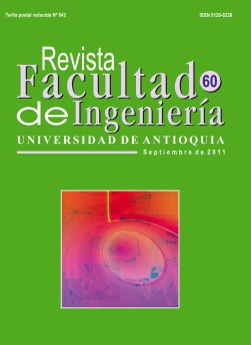Tactical planning of domestic supply chains
DOI:
https://doi.org/10.17533/udea.redin.13663Keywords:
integer programming, nonlinear programming, logistics, supply chain managementAbstract
This paper presents a single-period mathematical programming model NLMIP of a 5-stage supply chain with multiple possibilities of organizational ownership that allows several distribution channel links. The objective of the model is to optimize profit after tax, taking into account transfer prices, economies of scale, agreements between agents, demand and inventory issues, among other relevant aspects, specially in an idealised domestic environments. Finally, a solution procedure is presented for the problem associated with the NLMIP mathematical programming model proposed, that gives an optimal solution in satisfactory computational time. The model was validated using an experiment based on computational simulations.
Downloads
References
C. H. Aikens. “Facility location models for distribution planning”. European Journal of Operational Research. Vol. 22. 1985. pp. 263 - 279. DOI: https://doi.org/10.1016/0377-2217(85)90246-2
M. A. Cohen, H. L. Lee. “Strategic analysis of integrated production-distribution systems: Models and methods”. Operations Research. Vol. 36. 1988. pp. 216-228. DOI: https://doi.org/10.1287/opre.36.2.216
B. C. Arntzen, G. G. Brintegrated, T. P. Harrison, L. L. Trafton. “Global supply chain management at digital equipment corporation”. Interfaces. Vol. 25. 1995. pp. 69 - 93. DOI: https://doi.org/10.1287/inte.25.1.69
A. M. Geoffrion, R. F. Powers. “Twenty years of strategic distribution system design: An evolutionary perspective”. Interfaces. Vol. 25. 1995. pp. 105-127. DOI: https://doi.org/10.1287/inte.25.5.105
P. A. Slats, B. Bhola, J. J. M. Evers, G Dijkhuizen. “Logistic chain modeling”. European Journal of Operational Research. Vol. 87. 1995. pp. 1-20. DOI: https://doi.org/10.1016/0377-2217(94)00354-F
D. Thomas, M. C. Griffin. “Coordinate supply chain management”. European Journal of Operational Research. Vol. 94. 1996. pp. 1-15. DOI: https://doi.org/10.1016/0377-2217(96)00098-7
C. J. Vidal, M. Goetschalckx. “Strategic productiondistribution models: A critical review with emphasis on global supply chain models”. European Journal of Operational Research. Vol. 98. 1997. pp. 1-18. DOI: https://doi.org/10.1016/S0377-2217(97)80080-X
M. Goetschalckx, C. J. Vidal, K. Dogan. “Modeling and design of global logistic system: A review of integrated strategic and tactical models and design algorithms”. European Journal of Operational Research. Vol. 143. 2002. pp. 1-18. DOI: https://doi.org/10.1016/S0377-2217(02)00142-X
A. Gupta, C. D. Maranas. “Managing demand uncertain in supply chain planning”. Computers & Chemical Engineering. Vol. 27. 2003. pp. 1219 - 1227. DOI: https://doi.org/10.1016/S0098-1354(03)00048-6
C. Chen, W. Lee. “Multi-objective optimization of multi-echelon supply chain networks with uncertain product demands and prices”. Computers & Chemical Engineering. Vol. 28. 2004. pp. 1131 - 1144. DOI: https://doi.org/10.1016/j.compchemeng.2003.09.014
C. J. Vidal, M. Goetschalckx. “A global supply chain model with transfer pricing and transportation cost allocation”. European Journal of Operational Research. Vol. 129. 2001. pp. 134 - 158. DOI: https://doi.org/10.1016/S0377-2217(99)00431-2
F. Villegas, J. Ouenniche. “A general unconstrained model for transfer pricing in multinational supply chains”. European Journal of Operational Research. Vol. 187. 2008. pp. 829 - 856. DOI: https://doi.org/10.1016/j.ejor.2006.04.048
G. Mohan. Mixer integer programming models for supply chain integrated planning. Masters Thesis. Concordia University, Montreal. UMI Dissertation Information Service. 2003. pp. 133.
R. G. García, J. A. Araoz. F. Palacios. “Integral Analysis Method - IAM”. European Journal of Operational Research. Vol. 192. 2009. pp. 891- 903. DOI: https://doi.org/10.1016/j.ejor.2007.10.001
H. Viscencio. Economía para la Toma de Decisiones. Ed. Paraninfo. México. 2002. pp. 386.
K. C. Tan. “A framework of supply chain management literature”. European Journal of Purchasing and Supply Management. Vol. 7. 2001. pp. 39 - 48. DOI: https://doi.org/10.1016/S0969-7012(00)00020-4
W. M. Abdallah. International Transfer Pricing Policies: Decision Making Guidelines for Multinational Companies. Ed. Quorum Books. New York. 1989. pp. 162.
E. R. Silver, R. Peterson. Decision systems for inventory management and production planning. 2nd. ed. Ed. Wiley. New York. 1985. pp. 722.
P. M. Pardalos. S. A. Vavasis. “Quadratic programming with one negative eigenvalue is NP-hard.” Journal of Global Optimization. Vol. 21. 1991. pp. 843 - 855.
W. Hanson. R. K. Martin. “Optimal bundle pricing”. Management Science. Vol. 36. 1990. pp. 155 - 174. DOI: https://doi.org/10.1287/mnsc.36.2.155
Downloads
Published
How to Cite
Issue
Section
License
Copyright (c) 2018 Revista Facultad de Ingeniería

This work is licensed under a Creative Commons Attribution-NonCommercial-ShareAlike 4.0 International License.
Revista Facultad de Ingeniería, Universidad de Antioquia is licensed under the Creative Commons Attribution BY-NC-SA 4.0 license. https://creativecommons.org/licenses/by-nc-sa/4.0/deed.en
You are free to:
Share — copy and redistribute the material in any medium or format
Adapt — remix, transform, and build upon the material
Under the following terms:
Attribution — You must give appropriate credit, provide a link to the license, and indicate if changes were made. You may do so in any reasonable manner, but not in any way that suggests the licensor endorses you or your use.
NonCommercial — You may not use the material for commercial purposes.
ShareAlike — If you remix, transform, or build upon the material, you must distribute your contributions under the same license as the original.
The material published in the journal can be distributed, copied and exhibited by third parties if the respective credits are given to the journal. No commercial benefit can be obtained and derivative works must be under the same license terms as the original work.










 Twitter
Twitter